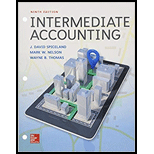
Factoring of
IFRS
• LO7–8, LO7–10
This is a variation of E 7–20 modified to focus on factoring with recourse under IFRS.] Mountain High Ice Cream Company reports under IFRS. Mountain High transferred $60,000 of accounts receivable to the Prudential Bank. The transfer was made with recourse. Prudential remits 90% of the factored amount to Mountain High and retains 10% to cover sales returns and allowances. When the bank collects the receivables, it will remit to Mountain High the obligation. The bank charges a 2% fee (2% of $60,000), and requires that amount to be paid at the start of the factoring arrangement. Mountain High has transferred control over the receivables, but determines that it still retains substantially all risks and rewards associated with them.
Required:
Prepare the
Want to see the full answer?
Check out a sample textbook solution
Chapter 7 Solutions
INTERMEDIATE ACCOUNTING(LL)-W/CONNECT
 Cornerstones of Financial AccountingAccountingISBN:9781337690881Author:Jay Rich, Jeff JonesPublisher:Cengage Learning
Cornerstones of Financial AccountingAccountingISBN:9781337690881Author:Jay Rich, Jeff JonesPublisher:Cengage Learning Intermediate Accounting: Reporting And AnalysisAccountingISBN:9781337788281Author:James M. Wahlen, Jefferson P. Jones, Donald PagachPublisher:Cengage Learning
Intermediate Accounting: Reporting And AnalysisAccountingISBN:9781337788281Author:James M. Wahlen, Jefferson P. Jones, Donald PagachPublisher:Cengage Learning


